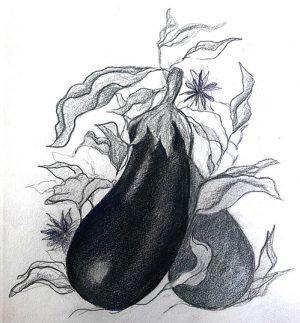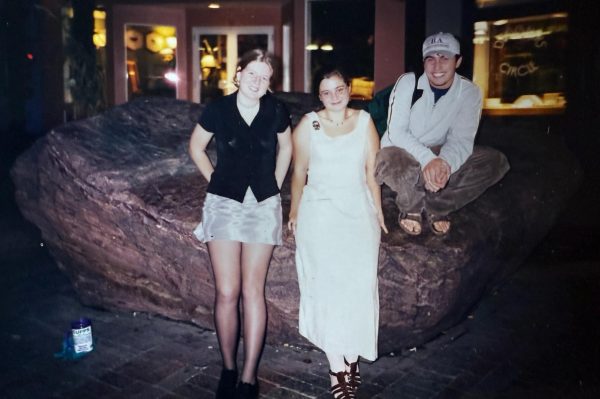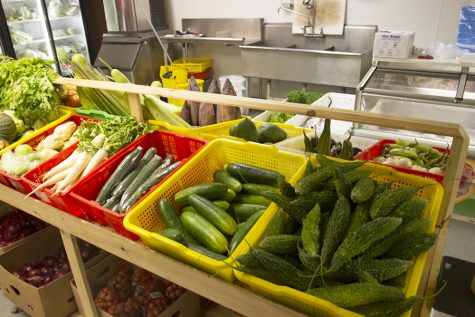Eggplants: Cooking and Connecting with the Old World
Food is culture. I am a first-generation Romanian-American, but I don’t know much about Romanian food. My father fled the country in the height of Ceausescu’s dictatorship, and once he moved to the United States, he was dedicated to being an American.
He won’t speak Romanian around my brother or me often, and when we eat together, we usually go out for noodles. Sometimes he will talk fondly of his grandparents’ farm, how they would grow plums and eggplants and he would help care for the animals. He still goes back there at least once a year to see the family that lives there now.
My cooking has never been very culturally inspired, only driven by local availability, price and my deep love for fresh vegetables. I know how to prepare zucchini, and I have developed some second-natured intuition for the tenderness of oven-roasted root vegetables.
For years I’ve been committed to the leafy greens and squashes of farmers’ markets. I have spent many afternoons perfecting my vegetable hash, a recipe-less medley of seasonal produce, dusted generously with salt and pepper and cooked in stages, so that the potatoes are golden-brown and the kale isn’t crispy or the garlic burned.
Once, in an attempt to be more creative in the kitchen, I bought the prettiest vegetable I had ever seen at the farmer’s market. It was an eggplant: oblong and shiny, a deep magenta with delicate white stripes. I had eaten plenty of eggplants before, but I had never cooked them myself.
I excitedly brought the eggplant home, treating it more like a new houseplant than a food, and placed it on my kitchen counter. Overconfident and more accustomed to cooking straight-forward potatoes, I chopped the eggplant into chunks and threw it into a pan of hot oil.
The skin quickly turned grayish, and the once-spongy white flesh absorbed all of the oil within seconds. I had no intuition for the vegetable. It wouldn’t sizzle. It wasn’t firming or softening. I seasoned it, waited and then reluctantly forked the pieces onto my plate. Whatever I had done was not right. I had naively mistaken it for any simple fry-until-golden-brown kind of vegetable.

I soon became fascinated with the art of cooking eggplant. It started with a phone call to my mom. She joked I was living my Romanian grandmother’s dream — Mica loved eggplants, she told me. My great-grandparents grew them on their farm outside of Bucharest, and Mica used to make a luscious Salată de Vinete, a traditional Romanian eggplant spread.
I had only met Mica once, when she came to the United States to see how my brother and I had grown and could only say “hello” and “I love you.” When she died a couple years later, the farm was left to my father, a self-proclaimed city boy. He grew up in a town outside of Bucharest infrequently visiting his grandparents’ farm, and never spent enough time in the kitchen to know the magic behind his mother’s eggplant dishes.
Having about as much knowledge of my cultural heritage as I did the proper preparation of the eggplant, my affinity for the vegetable only grew. Online, I found countless recipes, histories and iconographies.
I read every nostalgic narrative that accompanied traditional recipes, with stories of growing up eating eggplants cooked in Romania, Turkey, Egypt and India. Despite all of my research, when it was just me with a cutting board and a four-burner in my tiny kitchen, I was intimidated.
For the next eggplant I bought, I wouldn’t begin with any attempt at my grandmother’s Salată de Vinete. I would try and cook it in a pan, like I had before, but this time I was aiming for the velvety richness I had read about. I stood at my kitchen counter, and slowly sliced through the dark purple skin and cut the flesh into thin, spongy white ovals.
Each piece had to be salted, soaked in a colander, rinsed and then left to dry on paper towels. I heated up the oil in the pan, carefully placed the slices one-by-one, and waited. Every recipe said eggplants take time. My mother told me that once, when my grandmother came to visit, the oven became so hot from her eggplants roasting for such a long time that the window above the stove shattered.
Some recipes online described the transition from firm and spongy to soft and luscious as “the collapse.” I waited for the collapse. I added a little bit of salt and pepper. I flipped them. I started to see them soften. I didn’t break any windows.
I sat with my plate; the slices of eggplant were cooked through. Though my dish wasn’t all that interesting, the vegetable itself was. I felt connected to my father, to Mica, to my great-grandparents. One day, I’ll try and make the Salată de Vinete. One day, I’ll go to Romania with my father, I’ll see the farm and eat the eggplants of my ancestors. For now, I’ll sit alone in my kitchen with an eggplant, sliced thinly and cooked to collapse, salted and peppered and with every intention to cook another one tomorrow.










